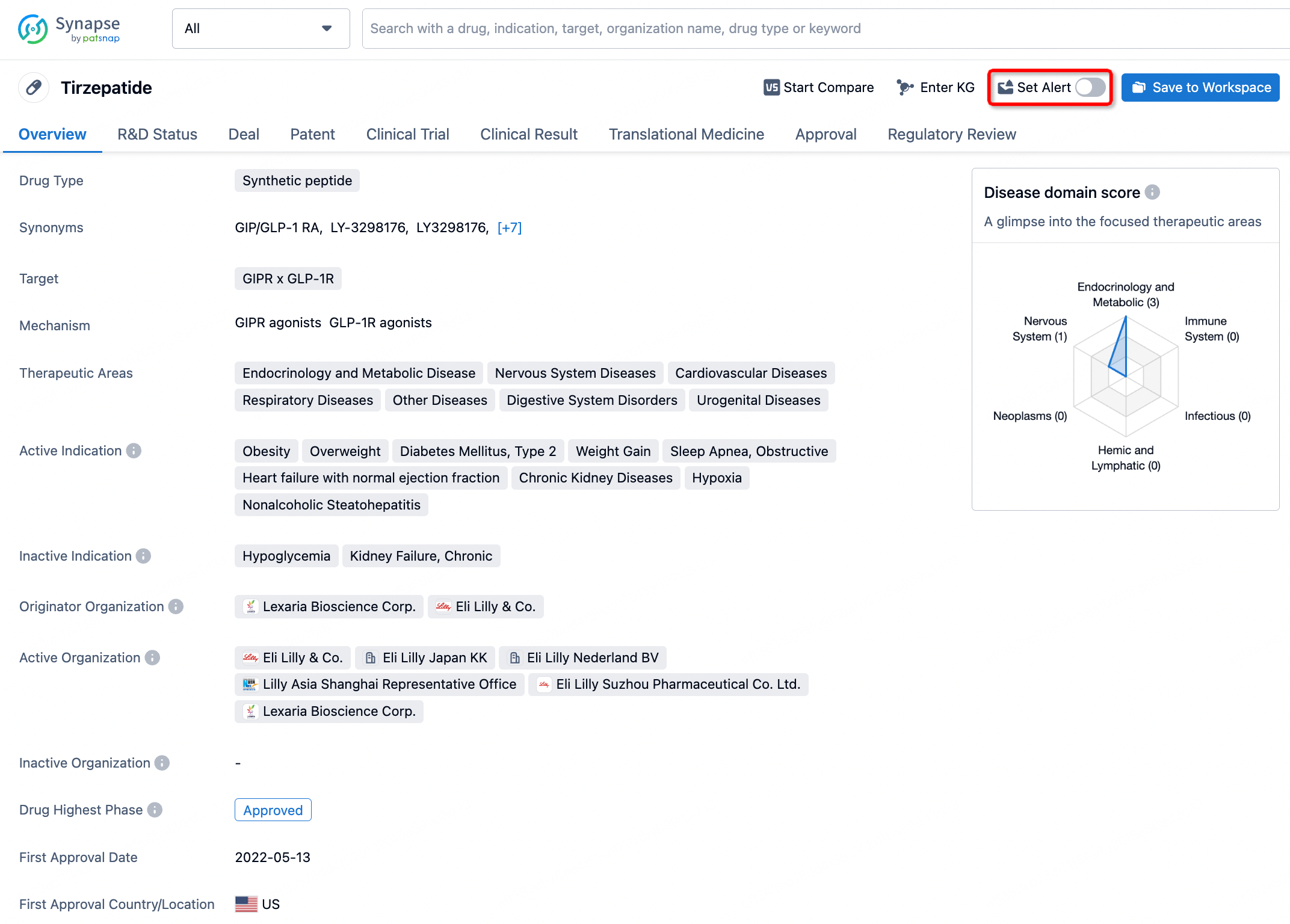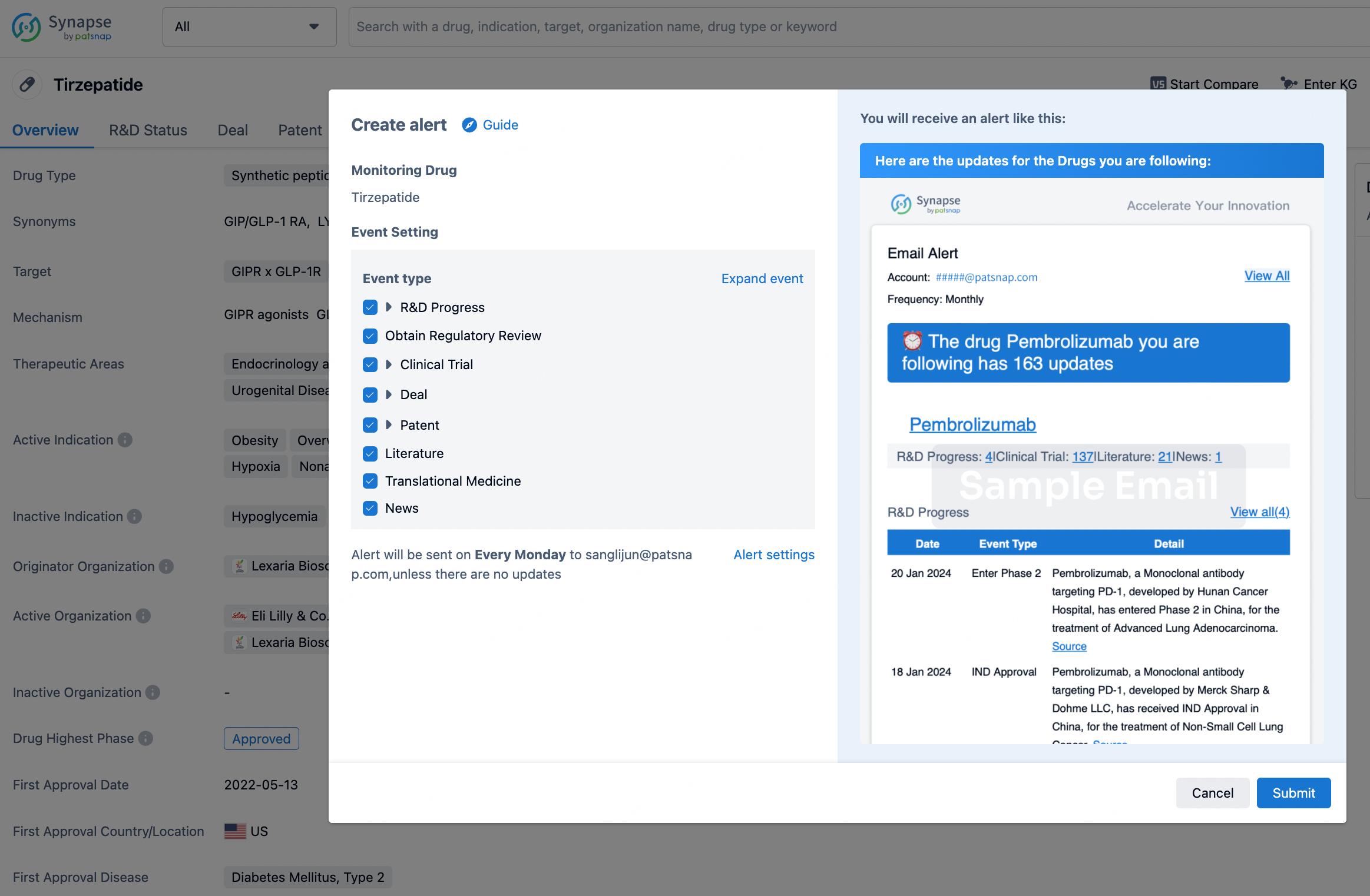Request Demo
What is the mechanism of 2 ,4-Dinitrochlorobenzene?
18 July 2024
2,4-Dinitrochlorobenzene (DNCB) is a chemical compound that is widely used in various scientific applications, including biochemistry and immunology. Its mechanism of action is of particular interest because it serves as a model compound for studying the effects of electrophilic aromatic substitution reactions and the immune response. This article delves into the mechanism of 2,4-Dinitrochlorobenzene, exploring its chemical properties, reaction pathways, and biological implications.
The chemical structure of DNCB contains a benzene ring substituted with two nitro groups at the 2 and 4 positions and a chlorine atom at the 1 position. The presence of these electron-withdrawing nitro groups makes the benzene ring highly reactive towards nucleophiles. This reactivity is pivotal in understanding the mechanism of electrophilic aromatic substitution (EAS) and nucleophilic aromatic substitution (NAS) reactions involving DNCB.
In electrophilic aromatic substitution, the nitro groups on the benzene ring deactivate the ring towards further electrophilic substitution due to their strong electron-withdrawing properties. However, DNCB primarily undergoes nucleophilic aromatic substitution due to the presence of the electron-withdrawing nitro groups. These groups make the carbon-chlorine bond more susceptible to attack by nucleophiles. The nitro groups stabilize the negative charge in the transition state and intermediate, facilitating the substitution process.
The mechanism of NAS in DNCB typically follows the addition-elimination pathway. A nucleophile, such as hydroxide ion (OH-), attacks the carbon atom bonded to the chlorine atom. This leads to the formation of a Meisenheimer complex, a negatively charged intermediate where the nucleophile is temporarily attached to the aromatic ring. The intermediate then expels the chloride ion, resulting in the substitution of the chlorine atom with the nucleophile. This process is greatly facilitated by the electron-withdrawing nitro groups, which stabilize the negative charge in the transition state and intermediate.
Beyond its chemical reactivity, 2,4-Dinitrochlorobenzene is also significant in biological systems, particularly in immunology. DNCB is commonly used to induce contact hypersensitivity (CHS) in experimental settings. CHS is a form of delayed-type hypersensitivity (DTH) that serves as a model for studying cellular immune responses. When DNCB is applied to the skin, it forms covalent bonds with skin proteins, rendering them immunogenic. These modified proteins are then processed by antigen-presenting cells (APCs) such as Langerhans cells, which migrate to the lymph nodes and present the antigen to T-cells. This process activates T-cells, leading to an immune response characterized by inflammation and swelling at the site of DNCB application.
The use of DNCB in immunological research has provided valuable insights into the mechanisms of T-cell activation and the role of various cytokines and chemokines in the immune response. Additionally, DNCB is employed in patch testing to diagnose contact dermatitis, a condition where the immune system reacts to small, reactive chemicals.
In summary, the mechanism of 2,4-Dinitrochlorobenzene involves its reactivity due to the electron-withdrawing effects of the nitro groups, which facilitate nucleophilic aromatic substitution. Its significance extends beyond chemistry into the realm of biological sciences, where it serves as a crucial tool for understanding immune responses and diagnosing allergic reactions. The study of DNCB continues to contribute to our knowledge of both chemical reactivity and immunological mechanisms.
The chemical structure of DNCB contains a benzene ring substituted with two nitro groups at the 2 and 4 positions and a chlorine atom at the 1 position. The presence of these electron-withdrawing nitro groups makes the benzene ring highly reactive towards nucleophiles. This reactivity is pivotal in understanding the mechanism of electrophilic aromatic substitution (EAS) and nucleophilic aromatic substitution (NAS) reactions involving DNCB.
In electrophilic aromatic substitution, the nitro groups on the benzene ring deactivate the ring towards further electrophilic substitution due to their strong electron-withdrawing properties. However, DNCB primarily undergoes nucleophilic aromatic substitution due to the presence of the electron-withdrawing nitro groups. These groups make the carbon-chlorine bond more susceptible to attack by nucleophiles. The nitro groups stabilize the negative charge in the transition state and intermediate, facilitating the substitution process.
The mechanism of NAS in DNCB typically follows the addition-elimination pathway. A nucleophile, such as hydroxide ion (OH-), attacks the carbon atom bonded to the chlorine atom. This leads to the formation of a Meisenheimer complex, a negatively charged intermediate where the nucleophile is temporarily attached to the aromatic ring. The intermediate then expels the chloride ion, resulting in the substitution of the chlorine atom with the nucleophile. This process is greatly facilitated by the electron-withdrawing nitro groups, which stabilize the negative charge in the transition state and intermediate.
Beyond its chemical reactivity, 2,4-Dinitrochlorobenzene is also significant in biological systems, particularly in immunology. DNCB is commonly used to induce contact hypersensitivity (CHS) in experimental settings. CHS is a form of delayed-type hypersensitivity (DTH) that serves as a model for studying cellular immune responses. When DNCB is applied to the skin, it forms covalent bonds with skin proteins, rendering them immunogenic. These modified proteins are then processed by antigen-presenting cells (APCs) such as Langerhans cells, which migrate to the lymph nodes and present the antigen to T-cells. This process activates T-cells, leading to an immune response characterized by inflammation and swelling at the site of DNCB application.
The use of DNCB in immunological research has provided valuable insights into the mechanisms of T-cell activation and the role of various cytokines and chemokines in the immune response. Additionally, DNCB is employed in patch testing to diagnose contact dermatitis, a condition where the immune system reacts to small, reactive chemicals.
In summary, the mechanism of 2,4-Dinitrochlorobenzene involves its reactivity due to the electron-withdrawing effects of the nitro groups, which facilitate nucleophilic aromatic substitution. Its significance extends beyond chemistry into the realm of biological sciences, where it serves as a crucial tool for understanding immune responses and diagnosing allergic reactions. The study of DNCB continues to contribute to our knowledge of both chemical reactivity and immunological mechanisms.
How to obtain the latest development progress of all drugs?
In the Synapse database, you can stay updated on the latest research and development advances of all drugs. This service is accessible anytime and anywhere, with updates available daily or weekly. Use the "Set Alert" function to stay informed. Click on the image below to embark on a brand new journey of drug discovery!
AI Agents Built for Biopharma Breakthroughs
Accelerate discovery. Empower decisions. Transform outcomes.
Get started for free today!
Accelerate Strategic R&D decision making with Synapse, PatSnap’s AI-powered Connected Innovation Intelligence Platform Built for Life Sciences Professionals.
Start your data trial now!
Synapse data is also accessible to external entities via APIs or data packages. Empower better decisions with the latest in pharmaceutical intelligence.


